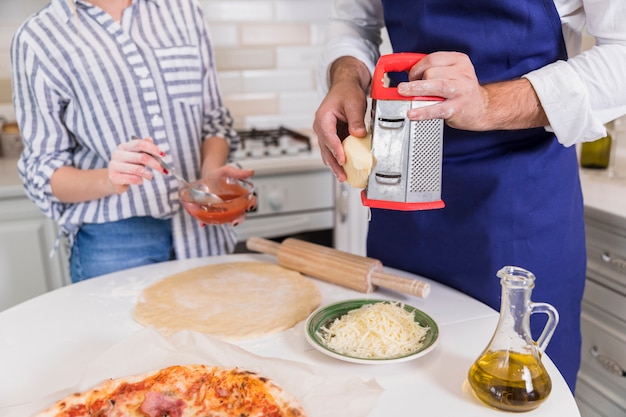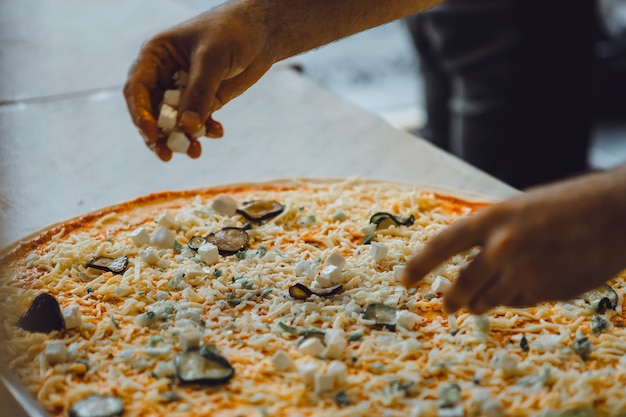You know that feeling – the anticipation, the excitement, the pure joy of a perfectly cooked pizza. That crisp, bubbly crust, the gooey, melted cheese, and those perfectly seasoned toppings all come together in a symphony of flavour. But achieving that pizza nirvana hinges on one crucial element: the temperature. Getting it right is the difference between a delicious pizza and a disappointing one, a game-changer in the pizza world. So, grab a slice (or two) and let's delve into the art and science of finding that perfect pizza oven temperature.
(Part 1) The Temperature Tango

The pizza oven – a mystical, magical realm of high heat and culinary transformations. You might think, "Isn't it just supposed to be as hot as the sun?" Well, it's a bit more nuanced than that. The ideal temperature isn't about simply cranking up the heat; it's about finding the right kind of heat for the specific task at hand. Too low, and you'll end up with a doughy, soggy mess. Too high, and you'll char the toppings before the crust has a chance to properly cook through. It's a delicate balance, a fiery dance between heat and time, a pizza-making tango, if you will.
The Ideal Range: The Sweet Spot for Crispy Perfection
For most pizza ovens, whether it's a roaring gas beast or a compact countertop model, the golden zone lies between 450°F and 550°F (232°C to 288°C). This range allows for a lovely, even heat that transforms the dough quickly, giving you that coveted crispiness on the bottom, while ensuring the cheese melts beautifully and the toppings cook without burning.
The Power of Preheating: Setting the Stage for Success
I can't stress this enough: preheating is your best friend in the pizza-making game. It's like getting your oven all warmed up and ready to go, revved up and ready for action. Preheating for at least 30 minutes is crucial. This ensures your oven reaches the target temperature and is ready to work its magic on your dough, turning it into a culinary masterpiece. And while you wait for your oven to reach that perfect heat, why not enjoy a cup of tea or a cheeky glass of something bubbly? After all, pizza-making is a journey, not just a destination.
(Part 2) Types of Pizza Ovens and Their Temperature Preferences

We all have our preferences when it comes to pizza ovens, don't we? The trusty old gas oven, the sleek countertop model, the majestic wood-fired behemoth – each has its own unique personality and temperature requirements. Let's explore these different ovens and their ideal temperature ranges to help you find your perfect pizza partner.
Home Ovens: The Everyday Hero
Your trusty home oven can surprise you with its pizza-making prowess, especially when you enlist the help of a pizza stone. Aim for the highest setting, usually around 500°F (260°C). You might need to experiment a bit to find the optimal temperature for your particular oven, but remember, a little exploration is part of the fun!
Gas Pizza Ovens: Powerhouses of Pizza Perfection
These ovens are real pizza-making powerhouses, boasting high heat output for those truly crispy crusts. You'll typically find their temperature range hovering between 500°F to 700°F (260°C to 371°C). But even with their impressive heat capabilities, preheating is still key. It's like warming up a high-performance sports car – you want to make sure it's ready to unleash its full potential.
Wood-Fired Ovens: The Authentic Pizza Experience
Ah, the wood-fired oven. The undisputed king of pizza-making, capable of reaching incredible temperatures, sometimes even up to 900°F (482°C). This intense heat gives the pizza that irresistible smoky flavour, a touch of culinary magic you can't replicate anywhere else. However, these ovens demand a certain level of skill and practice to master. It's like a culinary dance with fire, but the rewards are truly worth the effort.
Countertop Pizza Ovens: Convenience and Quality in One Package
For those with limited space or a desire for quick and easy pizza nights, countertop pizza ovens are a fantastic option. They typically operate in the range of 450°F to 550°F (232°C to 288°C). They are compact, efficient, and deliver excellent results, proving that good things can come in small packages.
(Part 3) The Pizza Dough Factor: The Foundation of Your Pizza Masterpiece

We've tackled the oven, but what about the heart of the pizza? The dough. It's the foundation upon which your pizza masterpiece is built, and it plays a critical role in how the pizza cooks. You need a dough that's strong enough to withstand the intense heat and rise evenly, forming a beautiful, crispy crust.
Flour and Hydration: The Secret Ingredients for a Strong Crust
The type of flour you choose is crucial. High-protein flours, like bread flour, are your pizza pals because they create a robust gluten network that can hold its shape in the oven, ensuring your pizza doesn't collapse under the weight of its delicious toppings. The hydration level, which is the ratio of water to flour, also plays a significant role. A higher hydration dough is more elastic, stretching beautifully and yielding a thin, crispy crust.
Proofing: Letting the Dough Breathe and Rise
The time you spend proofing your dough is equally important. Think of it as letting the dough breathe and rise, gaining strength and developing its character. Proofing too short, and your dough might be dense and chewy. Proofing too long, and it might be overproofed, collapsing in the oven. Aim for a dough that is light and airy, with a slight springiness when you poke it.
Stretching: The Art of Gently Shaping Your Dough
Stretching your dough before you send it into the oven is an essential step, a delicate dance of gentle manipulation. You want to stretch it out evenly, ensuring it cooks consistently. Stretch too much, and your crust might be too thin and fragile. Stretch too little, and your crust might be thick and doughy. The key is to find that sweet spot, a balance between elasticity and strength.
(Part 4) The Art of Placement: Finding the Perfect Spot in Your Pizza Oven
You've got your preheated oven, your perfectly proofed dough, and now it's time for the placement game. Where you position your pizza in the oven can significantly impact how it cooks. It's like finding the perfect spot in a crowded concert venue – the right location can make all the difference.
The Center Stage: The Hottest Spot for Maximum Crisp
In most pizza ovens, the center is the hottest spot, the equivalent of the front row at a concert. It's ideal for achieving that incredibly crisp crust. But be warned: it's also the most intense heat, so keep a close eye on your toppings to avoid burning.
The Mid-Row: A Balanced Approach for Even Cooking
If you're concerned about burnt toppings, consider placing your pizza a bit lower in the oven. This will give you more control over the heat, like being in the second row at the concert – still a good view but with a bit more space to breathe.
The Back Row: A Cooler Spot for Toppings that Need More Time
The back of the oven is often the coolest spot, perfect for pizzas loaded with toppings that require a little more time to cook through without burning. It's like being in the back row at the concert – you might not have the best view, but you can relax and enjoy the music without the pressure of being in the front row.
(Part 5) Signs of a Perfectly Cooked Pizza: The Visual Cues of Pizza Perfection
You've preheated your oven, stretched your dough, and strategically positioned your pizza. Now, it's time to watch for those telltale signs, those visual cues that signal pizza perfection. It's like reading a pizza horoscope, deciphering the secrets of its culinary destiny.
The Crust: A Golden Brown, Crispy Canvas
The crust is your primary indicator. It should be a beautiful golden brown, with a satisfying crispiness. You should hear that unmistakable crackle when you lift it up. If it's still doughy, it needs more time in the oven, a little longer in the fiery embrace.
The Cheese: Melted, Bubbly, and Perfectly Golden
The cheese should be melted, bubbly, and have a beautiful golden-brown crust. If it's still runny, it needs more time to reach that peak of cheesy perfection.
The Toppings: Cooked to Your Liking, a Symphony of Flavor
Your toppings should be cooked to your liking. If you crave a touch of char, let them bask a little longer in the oven's warmth. If you prefer them cooked through but not burnt, keep a watchful eye on them, ensuring they reach their full potential without sacrificing their integrity.
(Part 6) Adjusting the Temperature: Mastering the Art of In-Flight Adjustments
You've preheated your oven, you're ready to go, but sometimes, life throws you a curveball. You might need to make adjustments on the fly, like a skilled pilot navigating turbulent skies. Don't worry; it happens to the best of us. We're all pizza-making learners here, and a little improvisation can go a long way.
Too Hot: Dialing Down the Heat
If your oven is too hot, your pizza will cook too quickly, and those beautiful toppings might burn before the crust has a chance to crisp up. Lower the temperature slightly, like taking a step back from the heat source, or move the pizza closer to the back of the oven. It's like seeking a cooler spot in the sun, finding that perfect balance of warmth and comfort.
Too Cold: Turning Up the Heat
If your oven is too cold, your pizza won't cook through properly, and you'll end up with a soggy crust, a pizza tragedy in the making. Raise the temperature slightly, like getting a little closer to the action, or place the pizza closer to the center of the oven. It's like moving closer to the stage at a concert, immersing yourself in the heat of the music.
(Part 7) Pizza Oven Temperature Troubleshooting: Solving Those Pizza-Related Dilemmas
Even with the best intentions, even the most experienced pizzaiolo (that's a fancy word for pizza maker) might encounter a few challenges along the way. Pizza ovens can be a little temperamental, but don't despair! Here are a few troubleshooting tips to keep your pizza-making journey on track.
Uneven Cooking: The Importance of Rotation
If your pizza is cooking unevenly, you might need to rotate it halfway through baking. This ensures all parts of the pizza receive equal heat, like giving it a little pizza spin class.
Burnt Crust: A Sign of Excessive Heat
If your crust is burning, but the center of the pizza is still doughy, you might need to lower the oven temperature or move the pizza closer to the back of the oven. Remember, you can always adjust the temperature to find the sweet spot. It's like a pizza thermostat, allowing you to fine-tune your culinary masterpiece.
Soggy Crust: A Need for More Heat
If your crust is soggy, you might need to raise the oven temperature or ensure your pizza stone is preheated properly. Think of it as giving your pizza stone a good warm-up, making sure it's ready to transfer its heat to your dough.
(Part 8) The Secret Sauce: Experimentation, the Key to Pizza Perfection
I've shared the guidelines, the rules of the pizza-making game, but ultimately, finding the perfect pizza oven temperature is about experimentation. It's about getting your hands dirty, embracing the joy of trial and error, and discovering what works best for you, your oven, and your pizza preferences. It's a pizza-making adventure, a journey of culinary discovery.
Pizza Recipe Variations: Tailoring the Temperature to Your Pizza Style
Think about the type of pizza you're making. A thin-crust pizza will cook faster than a thick-crust pizza, so you might need to adjust the temperature accordingly. It's like tailoring your cooking style to the specific requirements of your pizza, finding the right fit for its unique personality.
Oven Variations: A Unique Identity for Each Oven
Remember, even ovens of the same type can have slightly different personalities, different quirks and nuances. You might need to make adjustments based on your specific oven. It's like tuning your pizza oven to your preferences, finding the frequency that resonates best with your pizza-making style.
Personal Taste: The Ultimate Guide to Pizza Perfection
And finally, don't forget about your personal taste. Some people love a crispy crust, while others prefer a softer, more chewy texture. Experiment until you find the temperature that delivers the perfect pizza for you. It's like finding your pizza soulmate, that perfect match of heat and flavor that sets your taste buds on fire.
(Part 9) Pizza Oven Temperature Chart: A Guide to Finding Your Pizza Sweet Spot
Here's a handy table to help you navigate the world of pizza oven temperatures. Keep in mind that these are just guidelines; you might need to adjust them based on your oven and the type of pizza you're making. It's a starting point, a map to guide you on your pizza-making journey.
| Pizza Oven Type | Ideal Temperature Range |
|---|---|
| Home Oven | 450°F to 500°F (232°C to 260°C) |
| Gas Pizza Oven | 500°F to 700°F (260°C to 371°C) |
| Wood-Fired Oven | 600°F to 900°F (315°C to 482°C) |
| Countertop Pizza Oven | 450°F to 550°F (232°C to 288°C) |
(Part 10) FAQs: Pizza Oven Temperature Edition
Let's tackle those burning pizza-related questions, the mysteries that keep pizza enthusiasts up at night. We're here to shed light on the shadows of pizza confusion, to illuminate the path to pizza enlightenment.
What if my oven doesn't have a temperature setting?
Don't fret! You can use an oven thermometer to check the temperature of your oven. Place the thermometer on the center rack and preheat it for at least 30 minutes before you start cooking your pizza. It's like having a pizza guardian angel, making sure your oven is ready to fulfill its destiny.
How do I know if my pizza stone is hot enough?
The water test is your friend. Sprinkle a few drops of water on the pizza stone. If the water sizzles and evaporates quickly, your pizza stone is ready to rock and roll.
Can I use a baking sheet instead of a pizza stone?
You can use a baking sheet, but a pizza stone will give you a crispier crust, a truly satisfying crunch. Just make sure the baking sheet is preheated before you add your pizza, ensuring a consistent heat transfer.
What if I don't have a pizza peel?
Don't let the lack of a pizza peel stop you! You can use a baking sheet or a large, flat spatula to slide your pizza into the oven. Just be careful not to let the pizza slide off the edge, a pizza-making tragedy waiting to happen.
What's the best way to clean my pizza stone?
Let your pizza stone cool completely, then scrub it with a stiff brush. You can also sprinkle a little bit of coarse salt on the stone and scrub it with a damp sponge. Avoid using soap or detergents, as they can damage the stone. Think of it as giving your pizza stone a little TLC, keeping it in tip-top shape for your next pizza adventure.
So, there you have it. A guide to finding the perfect pizza oven temperature, a path paved with knowledge, experimentation, and a whole lot of pizza love. Now go forth, my fellow pizza enthusiasts, and create culinary magic. The pizza world awaits your creations!
Everyone is watching

Prime Rib Roast Cooking Time Chart: Per Pound Guide
Cooking TipsPrime rib roast. Just the name conjures images of lavish dinners, crackling fires, and hearty laughter. It’s ...

How Long to Bake Potatoes in the Oven (Perfect Every Time)
Cooking TipsBaked potatoes are a staple in my kitchen. They're incredibly versatile, delicious, and surprisingly easy to m...

Perfect Rice Every Time: The Ultimate Guide to Cooking Rice
Cooking TipsAs a self-proclaimed foodie, I've always been a bit obsessed with rice. It's the foundation of countless cuisi...

The Ultimate Guide to Cooking Asparagus: Tips, Techniques, and Recipes
Cooking TipsAsparagus. The mere mention of this spring delicacy conjures up images of vibrant green spears, crisp and burs...

Ultimate Guide to Cooking the Perfect Thanksgiving Turkey
Cooking TipsThanksgiving. Just the word conjures up images of overflowing tables laden with delicious food, the scent of r...
